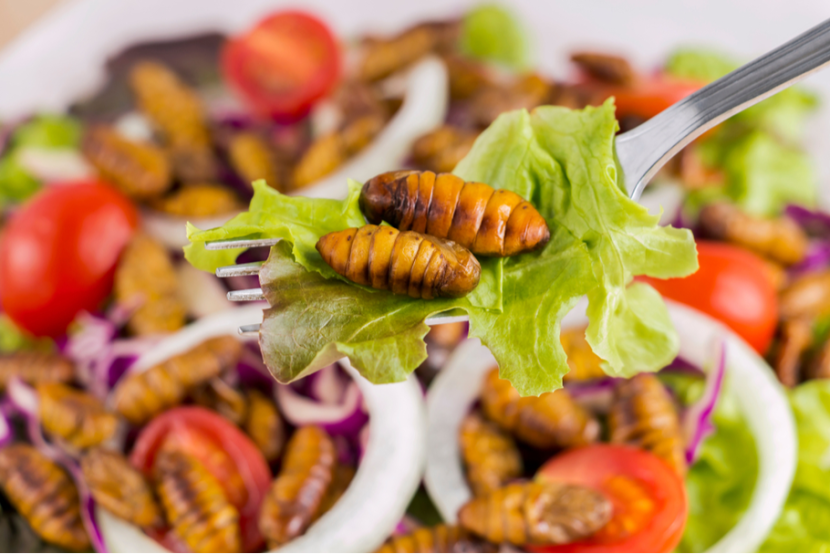Edible Insect Proteins as Novel Foods Need More Understanding and Oversight
By Suzanne Osborne
Edible insects have a long history of consumption in Africa, Asia, and Latin America, but they have only recently appeared in Western diets. Nutritional and sustainable to produce, insects may be a solution to future global food security.
Despite a history of being safely eaten, there is limited scientific data on the risks of foodborne pathogens in edible insects. The industry lacks best practice guidelines and there is no regulatory framework to ensure the safe production or processing of insects as food. Current limits for biological hazards are primarily extrapolated from the allowable limits in other foodstuffs. Since pathogens have unique growth, behaviour, and transmission patterns in different foods, these extrapolated limits are insufficient to ensure food safety.
Despite a history of being safely eaten, there is limited scientific data on the risks of foodborne pathogens in edible insects.
The Presence of Microbial Hazards in Edible Insects
Research shows that edible insects naturally harbor a large number of microorganisms, yet common pathogens such as Salmonella, Escherichia coli, Campylobacter, and Listeria monocytogenes are consistently absent from tested samples. Instead, retail samples routinely test positive for Staphylococcus aureus, Clostridium, and Bacillus cereus which still pose a risk to human health. This suggests that edible insects have unique bacterial hazard profiles compared to traditional food animals. To date, mycotoxins have been detected in low levels in edible insect products as well as their feed substrates. The fate of mycotoxins and their metabolites in individual insect species is unknown.
There is some evidence that edible insects are a vector for transmitting parasites to humans. A recent study examined parasite levels across 300 insect farms in Europe. They found that 81% of the samples contained parasites, of which over 30% were potentially transmittable to humans and animals.
Therefore, there are multiple biological hazards which, without regulations, put consumers at risk.
Sources of Contamination
The microbial composition of insects is primarily determined by their feed. As such, housing material and feed are critical hazard control points for contamination. In efforts to create a circular economy, some insect farms use livestock manure or diverted food waste as feed. Studies have documented that safety risks were higher in insects that were fed kitchen discards compared to those given specialized feeds.
Biosecurity is another critical control point in the farming of edible insects. The presence of pathogens in edible insects has often been linked to infected animals having access to the housing facility.
Recommendations for Safe Insect Farming
Though the edible insect industry lacks specific regulation, there are several key recommendations that frequently appear in the literature surrounding their consumption:
- Producers should exercise great care in selecting breeders when starting an insect colony; ensuring they are acquiring insects from reputable sources. Insects should be farmed in closed environments to prevent interaction with livestock or wild animals.
- The use of specialized feed over diverted kitchen or animal waste is an important strategy to reduce safety risks. Fermentation of the feed substrate has also been recommended to reduce the growth of both spoilage and pathogenic microorganisms.
- Due to the high microbial load naturally present on insects, experts strongly recommend heat inactivation to ensure food safety. Boiling, roasting, deep-frying, and blanching have proven to be effective in reducing the microbial risks. Some producers will starve the insects at the end of the rearing cycle in an effort to empty their gut and reduce the microbial load, however, results from this practice are inconsistent and it should not be considered sufficient to reduce safety risks.
- Standard good hygiene practices including the wearing of gloves and the disinfection of housing and equipment are also recommended.
Building the Edible Insect Industry
Edible insects show huge promise as an environmentally friendly solution to the world’s growing demand for protein. Despite a history of safe consumption, research shows that there are potential food safety concerns. As edible insect products try to make headway into Western markets, a lack of regulation and best practices leaves the industry vulnerable to recalls and swift erosion of consumer trust.
About the Author:
Dr. Suzanne Osborne’s expertise is in the field of host-pathogen interactions and food borne bacteria. She obtained her doctoral degree at McMaster University and worked as a Research Fellow at the Hospital for Sick Children (Toronto). She has received numerous awards for her research. Suzanne currently does freelance science writing and grant writing. She is a regular contributor to GFSR.

-
 FeaturedRisk management
The Cost of a Breach: What a Cyberattack Could Mean for Food Safety Recalls
FeaturedRisk management
The Cost of a Breach: What a Cyberattack Could Mean for Food Safety Recalls
-
 FeaturedRisk management
Securing the Food Chain: How ISO/IEC 27001 Strengthens Cybersecurity
FeaturedRisk management
Securing the Food Chain: How ISO/IEC 27001 Strengthens Cybersecurity
-
 FeaturedRisk management
Revolutionizing Food Safety Training: Breaking Out of the “Check-the-Box” Mentality
FeaturedRisk management
Revolutionizing Food Safety Training: Breaking Out of the “Check-the-Box” Mentality
-
 GFSI Standards
GFSI 2025: Building Trust, Tech-Forward Solutions, and Global Unity in Food Safety
GFSI Standards
GFSI 2025: Building Trust, Tech-Forward Solutions, and Global Unity in Food Safety
-
 FeaturedFood Safety
Integrated Pest Management: Strategies to Protect Your Brand’s Reputation
FeaturedFood Safety
Integrated Pest Management: Strategies to Protect Your Brand’s Reputation
-
 FeaturedFood Safety Culture & Training
No Open Door Policy: Challenges That Impact Pest Control in Food Processing Plants
FeaturedFood Safety Culture & Training
No Open Door Policy: Challenges That Impact Pest Control in Food Processing Plants




